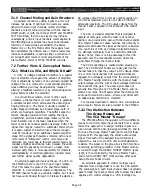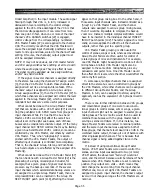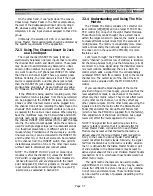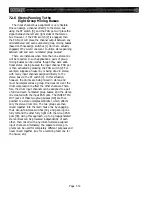
Fader, which is changeable via internal preset switches;
the Group bus calibration must still be done first to
establish the proper levels on the group busses ahead of
the Group Masters. The same concept applies to the
stereo bus.)
Here, a similar approach can be used, monitoring the
matrix outputs one at a time with the Matrix CUE
switch, adjusting any individual matrix controls you
wish to include in that matrix mix first to the nominal
(heavy line) setting, then reducing the setting of some of
these controls to obtain the desired mix, and finally
bringing up the MTRX MASTER control to nominal
position (#10) and, if necessary, reducing the contribut-
ing matrix mix controls by an equal amount to avoid
too-high bus levels.
7.1.7 Establishing The Correct
Aux Return Settings
With the aux sends calibrated, any external signal
processors (effects units such as reverbs, delay lines,
phasers, etc.) which are fed from the aux system can be
adjusted for optimum input and output levels. Assum-
ing the auxiliary processors are brought into one or
more of the PM4000 stereo input channels, those
channels (used as returns) are ready to be calibrated.
The CUE switch for any of these input channels of little
value in calibration because it derives signal ahead of
the EQ and fader. Instead, with the channel fader at
nominal position, use the channel LED meter, PAD and
GAIN control to set up for a nominal input level of
about 0 on the meter. Once all returning aux inputs
have been so calibrated, it is possible that their addi-
tional signal contribution to any assigned busses may
have raised the overall bus level too high. Again check
the VU meters on affected GROUP, AUX or STEREO
busses. In this case, the bus Masters may be used for
minor “touch up” level adjustments. If the level is much
too high on a given bus, do not pull down its Master
more than a few dB; instead, lower the Faders or Level
controls for all signals which contribute to that bus.
7.1.8 How VCA Control Affects
Gain Structure
Use of the VCA Master fader can complicate the gain
structure considerably. It is important to set up the
input PAD switch and GAIN controls using the tech-
nique previously described, including any level compen-
sation for EQ boost. The channel Faders initially should
be set at nominal position, and any VCA Masters to
which the input channel is assigned should be set at
nominal position as well. When all VCA Masters are at
their nominal position (green “NOMINAL” pointer
illuminated), the gain structure can be approached
pretty much as outlined previously. If, however, a given
input channel is assigned so that it is affected by
several VCA Masters, and any of those VCA Masters is
raised in level, then the input channel Fader levels is
effectively increased. If enough VCA Masters are raised
to the point where input channel VCA gain can go no
higher (as indicated when the red VCA MAX LED turns
on), then the offending VCA Masters should be lowered
slightly to correct the situation, or the channel Fader
should be lowered. If the adjustments adversely affect
the balance between VCA groups, all VCA Masters then
can be lowered, or the input Faders of the other chan-
nels can be lowered somewhat.
Figure 7-1. Control Voltages From up to 9 Differ-
ent Points (the Channel Fader Plus 8 VCA Master
Faders) Can Affect any Channel’s VCA Gain
CAUTION: If you assign or unassign an
input channel to a VCA Master group
during a performance, the channel gain
will jump up or down unless the corre-
sponding VCA Master Fader is set pre-
cisely to the nominal position (green LED
“NOMINAL” indicator illuminated).
Page 7-3
Summary of Contents for PM4000
Page 1: ...PROFESSIONAL AUDIO MIXING CONSOLE PM4000 OPERATING MANUAL YAMAHA ...
Page 2: ...PM4000 OPERATING MANUAL ...
Page 7: ...Section 1 Introduction ...
Page 11: ...Section 2 Brief Operating Instruction ...
Page 47: ...Section 3 Specifications ...
Page 51: ...Dimensional Drawings PM4000 Console all versions Page 3 4 ...
Page 52: ...Page 3 5 ...
Page 53: ...Page 3 6 PM4000 Console Rear Profiles ...
Page 54: ...Module Block Diagrams See back of the manual for overall system block diagram Page 3 7 ...
Page 55: ...Page 3 8 ...
Page 56: ...Page 3 9 ...
Page 57: ...Page 3 10 ...
Page 58: ...Page 3 11 ...
Page 59: ...Page 3 12 ...
Page 60: ...Section 4 Installation Notes ...
Page 72: ...Figure 4 13 Cables For Use With Balanced Sources Page 4 12 ...
Page 79: ...SECTION 5 Gain Structure and Levels ...
Page 82: ...Figure 5 1 Dynamic Range and Headroom in Sound Systems Page 5 3 ...
Page 86: ...Section 6 Optional Functions ...
Page 106: ...Section 7 Operating Notes and Hints ...
Page 119: ...Section 8 Applications ...
Page 127: ...Section 9 Maintenance ...
Page 131: ......
Page 132: ...YAMAHA VN02300 ...
















































